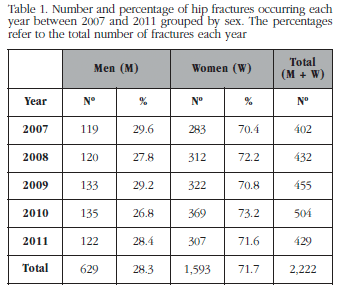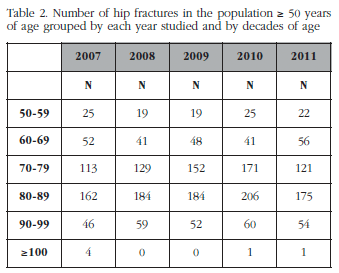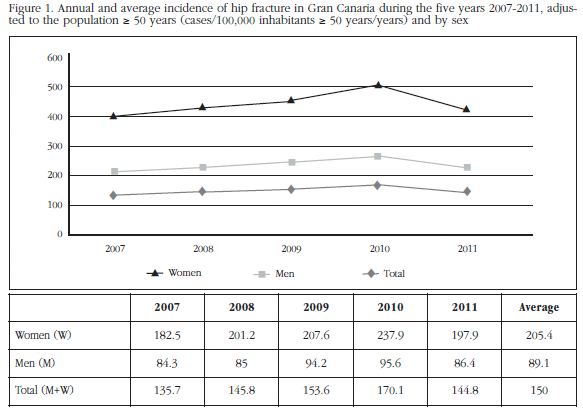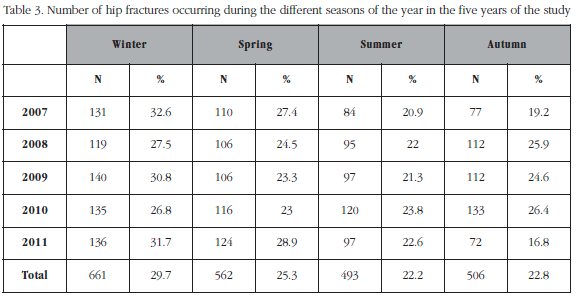Meu SciELO
Serviços Personalizados
Journal
Artigo
Indicadores
-
 Citado por SciELO
Citado por SciELO -
 Acessos
Acessos
Links relacionados
-
 Citado por Google
Citado por Google -
 Similares em
SciELO
Similares em
SciELO -
 Similares em Google
Similares em Google
Compartilhar
Revista de Osteoporosis y Metabolismo Mineral
versão On-line ISSN 2173-2345versão impressa ISSN 1889-836X
Rev Osteoporos Metab Miner vol.5 no.1 Madrid Jan./Mar. 2013
https://dx.doi.org/10.4321/S1889-836X2013000100005
Epidemiology of hip fracture in Gran Canaria over the five year period of 2007-2011
Epidemiología de la fractura de cadera en Gran Canaria durante el quinquenio 2007-2011
Vega Rodríguez N.1, Limiñana Cañal J.M.1, Arbelo Rodríguez A.2, Medina Henríquez J.A.3, Cabrera Domínguez D.4, Blázquez Gómez C.5, Gómez de Tejada Romero M.J.6, Sosa Henríquez M.1,7
1 Universidad de Las Palmas de Gran Canaria - Grupo de Investigación en Osteoporosis y Metabolismo Mineral
2 Hospital Universitario Dr. Negrín - Servicio de Traumatología
3 Hospital Universitario Insular - Servicio de Traumatología
4 Hospital Universitario Insular - Servicio de Admisión y Consultas Externas
5 Hospital Universitario Dr. Negrín - Servicio de Codificación
6 Universidad de Sevilla - Departamento de Medicina
7
Hospital Universitario Insular - Servicio de Medicina Interna - Unidad
Metabólica Ósea
SUMMARY
Background: Hip fracture is the most serious clinical complication of osteoporosis, due to its raised morbidity and mortality.
Method: We have studied the epidemiological and demographic characteristics of all the fragility fractures of the hip occurring in patients of ≥ 50 years of age recorded in Gran Canaria during the 5 year period of 2007-2011 from the admission, coding, emergency and traumatology services of all the hospitals in Gran Canaria, in both the public and private healthcare sectors.
Results: A total of 2,222 hip fractures were recorded, of which 1,593 (71.7%) occurred in women and 629 (28.3%) in men. The female/male ratio was 2.53. The average age at which the fractures occurred was 79 ± 9.7 years. Over the 5 years, the total number of fractures (men and women) varied between 402 (in 2007) and 504 (in 2010). The number of fractures increased with age up to the 90s. The annual global incidence was 150 cases/100,000 inhabitants ≥ 50 years: in women 205.4 cases with respect to the population of this sex and age, and in men, 89.1 with respect to the population of men ≥ 50 years. During the winter months 29.7% of the total fractures occurred, 7.5% more than those happening during the summer months (22.2%).
Conclusions: During the period 2007-2011 the incidence of hip fracture in Gran Canaria remained more or less stable, in every year being greater in women than in men, and increasing with age up until the 90s. The greatest number of hip fractures occurred during the winter months, with similar numbers in spring, summer or autumn.
Key words: fracture, hip, osteoporosis, epidemiology, incidence, Gran Canaria.
RESUMEN
Fundamento: La fractura de cadera constituye la complicación clínica más grave de la osteoporosis, por su elevada morbilidad y mortalidad.
Método: Hemos estudiado las características epidemiológicas y demográficas de la totalidad de fractura de cadera por fragilidad ocurridas en pacientes de ≥ 50 años de edad y recogidas en la isla de Gran Canaria durante el quinquenio 2007-2011, a partir de los Servicios de Admisión, Codificación, Urgencias y Traumatología de todos los hospitales de Gran Canaria, tanto de la red asistencial pública como privada.
Resultados: Se recogieron un total de 2.222 fracturas de cadera de las cuales 1.593 (71,7%) se produjeron en mujeres y 629 (28,3%) en hombres. La relación mujer/hombre fue de 2,53. La media de la edad de producción de fracturas de cadera fue de 79 ± 9,7 años. A lo largo de los 5 años, el número total (hombres y mujeres) de fracturas de cadera anuales osciló entre 402 (año 2007) y 504 (año 2010). El número de fracturas de cadera aumentó con la edad hasta la década de los 90 años. La incidencia anual global fue de 150 casos/100.000 habitantes ≥ 50 años, siendo en las mujeres de 205,4 casos respecto a la población de este sexo y edad, y en los hombres de 89,1 casos respecto a la población de hombres ≥ 50 años. Durante los meses de invierno se produjo el 29,7% del total de fracturas, un 7,5% más de las que ocurrieron durante los meses de verano (22,2%).
Conclusiones: Durante el período 2007 a 2011, la incidencia de fractura de cadera en Gran Canaria se mantuvo más o menos estable, siendo en todos los años mayor en las mujeres que en los hombres, y aumentando con la edad hasta los 90 años. El mayor número de fracturas de cadera se produjo durante los meses de invierno, siendo semejante durante la primavera, verano y otoño.
Palabras clave: fractura, cadera, osteoporosis, epidemiología, incidencia, Gran Canaria.
Introduction
The fracture of the proximal extremity of the femur, usually known as a hip fracture, is the most serious complication of osteoporosis [1,2]. This is due, on the one hand, to its mortality, both in the acute phase and in the following years, and on the other hand, to its morbidity, since a high proportion of patients after fracture require rehabilitation, continued assistance, or are institutionalised [3].
Fracture of the hip is an appropriate fracture with which to carry out epidemiological studies, given that all the patients who suffer from it are admitted to a hospital, and a huge majority usually require surgery. This factor is facilitated by the phenomenon of insularity of the island of Gran Canaria, which prevents the loss of cases due to movement or emergency treatment in neighbouring provinces.
We present in this study the epidemiological characteristics of all the cases of fracture occurring in the island of Gran Canaria during the period 2007-2011.
Patients and methods
In order to carry out this study we have consulted the archives and the discharge reports of the admissions, emergency, codification and traumatology services of all the hospitals of the island of Gran Canaria, both in the private and public sector.
Thus, all cases of hip fracture which were registered in the island of Gran Canaria from the 1st January 2007 to 31st December 2011 according to the criteria of the International Classification of Diseases (ICD 9), published by the Ministry of Health and Consumers Affairs [4], were recorded. All those cases in which: a) the patients lived in other autonomous communities or other countries, and who were only temporarily on the island; b) the fracture were the result of a high impact trauma: a traffic accident, a fall from a height greater than ones own feet, an attack, etc; and c) the fracture was pathological (neoplasms, Paget, bone cysts...).
Statistical analysis: the data were exported to an Excel® spreadsheet and later analysed using the statistical software package SPSS® version 18.0 (Statistical Package for the Social Sciences, Chicago, IL).
To study the incidence of cases, we obtained the data of the population aged ≥ 50 years, stratified by age and sex, from the public census data published by the Canarian Statistical Institute [5].
The distribution of frequencies was analysed in the case of discrete variables (sex, age groups), and mean ± standard deviation (SD) in the cases where they were continuous (age and hospital stay). The distribution of the variables was evaluated by means of the Kolmogorov-Smirnov test, and for the comparison of the means the Student's t-test was applied when the variable studies followed a normal distribution, and the Wilcoxon test when it did not. In all cases the significance level was established at 5% (p<0.05).
Results
A total of 2,222 fractures were recorded, of which 1,593 (71.7%) occurred in women and 629 (28.3%) in men. The female/male ratio was 2.53. The mean age of all the patients was 79 ± 10 years, 76 ± 11 years for the women, and 80 ± 9 years (p<0.001) for the men.
Analysing the data annually, the percentage of women who suffered from a hip fracture was always higher than 70%. The total number of fractures occurring annually varied between the 402, which occurred in 2007, and the 504, which happened in 2010 (Table 1).
In studying the number of hip fractures occurring each year as a function of age, it was observed that it increased for each decade of life in all the years recorded, until a maximum peak in the incidence when patients were in their 80s, and with a notable reduction in nonagenarians, also in all the years studied. Six cases of fractures of the hip were recorded in patients whose age was ≥ 100 years (Table 2).
Figure 1 shows the annual incidence of hip fracture during the years studied, expressed as the number of cases/100,000 inhabitants ≥ 50 years of age/year. The incidence was more than double in the women than in the men, both in each year studied and in the average of all the years. The average incidence of the 5 years studied was 89.1 cases/100,000 inhabitants in men and 205.4 cases/100,000 in women. Overall, including the whole population of both sexes, the annual incidence was 150 cases/100,000 inhabitants. The variation in the incidence of hip fracture over the 5 year period was small. The maximum overall incidence occurred in the year 2010 and the minimum in the year 2007, with a difference between them of 34.1 cases/100,000 inhabitants ≥ 50 years of age/year.
When the data were analysed taking into account the seasons of the year, it was observed that during the winter months the greatest number of cases occurred in each and every one of the years, while the number of hip fractures during the remaining seasons was variable depending on the year. Taking into account the figures for the 5 year period, summer was the season with fewer hip fractures (N=493) (Table 3).
The mean length of hospital stay was 8.8 ± 7.8 days, being significantly higher in men (9.4 ± 8.3 days) than in women (8.9 ± 7.3 days; p<0.05).
Discussion
Hip fracture is the most serious complication of osteoporosis, given that patients who suffer from it have a raise level of morbidity and mortality [1-3,6,7].
We have available many studies of the epidemiology of hip fracture in Spain, which were carried out above all in the decade of the 90s [8-11]. Also at this time, the results of the MEDOS study were published which in general terms described the incidence of cases of hip fracture in our country as being much lower than that which existed in other European countries [12,13], above all the Nordic countries, for which reason Spain was considered to be a zone of medium-low risk for hip fracture [12,13].
However, these incidence rates varied greatly from one place to another. Thus, in a review carried out in the year 2002 [14] which referenced all the studies of incidence of hip fracture carried out in Spain, showed an overall incidence in older people of 517 cases per 100,000 inhabitants/year; 270 cases in men and 695 in women. In the Canary Islands the incidence adjusted for age and year was the lowest in the whole country, with 301 cases/inhabitants and year, while in Catalunia, for example, at the other extreme of Spain, the incidence was 897 cases/100,000 inhabitants/year in the population of both sexes. We should note that in this study the population of 65 years and over was selected, which means that the incidence figures given did not coincide with ours, since we analysed hip fractures in subjects over 49 years of age [15].
Islands are an ideal place to carry out epidemiological studies, both of hip fractures and any other serious pathology [16], because the insularity acts as a type of filter which prevents the loss of data, above all in a pathology such as hip fracture which necessitates urgent admission to hospital in all cases, and almost always a later surgical intervention [17].
Hip fractures continue to be a pathology pertaining to individuals of an advanced age. The average age of our patients was 79 years, being significantly higher in women than in men. This age is very similar to that reported in most of the series published in Spain [8-11,14]. The fact that the number of hip fractures increases with age up to 90 years of age is illustrative. The reason why the number of cases drops from this point lies in the fact that mortality at this age is high and, therefore, the population is less. Nevertheless, it should be noted that the high number of cases in nonagenarian patients, and even in those of 100 years of age or more, is as consequence of the progressive aging of our population and its better quality of life. In our series, all the patients aged more than 100 years underwent surgical intervention and were discharged from hospital, which perhaps means that these data suggest the necessity for a more interventionist and less conservative approach to the treatment of hip fracture in centenarians, although the discussion of this topic is beyond the objectives of our work.
Also, hip fracture continues to be a pathology which is more frequent in women, with the female/male ratio in our study being 2.53, very similar to that found both in most of the studies carried out in Spain, as well as by our group in an epidemiological study carried out 20 years ago in the population of Gran Canaria [15].
In a study carried out in another region of Spain (Cantabria) an increase in the incidence of hip fractures was observed after a period of 12 years [10]. The objective of this study was to describe the epidemiology of hip fracture in the period 2007-2011 in Gran Canaria, and while we don't yet have available the results which compare the current incidence with those of 20 years ago [15], this is a study we are working on.
On the other hand, the number of hip fractures was greater in the winter months. A factor which could have had an influenced on this is a lower production of vitamin D at this time of year. In spite of the fact that Gran Canaria enjoys adequate and consistent levels of sunshine throughout the year, in studies carried out by our working group in medical students in Gran Canaria, it was observed that 61.2% of them had values of 25(OH) vitamin D below 30 ng/ml [18], for reasons we are not able to determine [19]. Although to clarify this fact, it would be necessary to understand the circumstances in which hip fractures occurred. It is possible that sunshine has a significant role, given the lower number of hip fractures which occur on average in the summer, the period of greatest sunshine.
In recent years the average stay in hospital of patients with hip fracture in Gran Canaria has been below 9 days. These figures concur with current figures in the rest of Spain [20], and are much lower than those of 20 years ago in our population, when the average hospital stay was 15.9 ± 15 days [15]. This is indicative of better postoperative management of hip fracture and the awareness of the need for early rehabilitation outside the hospital environment to reduce the morbimortality of these patients. We have found no explanation for the shorter hospital stay in women, although their lower age at the time of the hip fracture may mean better postoperative recovery, and a greater facility for extra-hospital recuperation.
One of the limitations of our study is that, in the case of hip fractures registered in public hospitals, in being in line with the published codes for the International Disease Classification criteria [4], some cases could have been lost, since there is not a single code which codifies hip fractures, it being able to be assigned very different codes at the time of admission or discharge, a phenomenon which we have noticed recently [21]. If this were to happen, we think that it would only occur in a few cases and, above all, in public hospitals, given that the clinical characteristics of these patients in hospitals (high costs, complications, non-negligible levels of mortality and notably lower number of cases), makes us think that the number of cases of hip fracture lost in the private care system would be practically nonexistent.
As a conclusion to the results obtained in this epidemiological study of osteoporotic hip fracture in Gran Canaria over the five years 2007-2011, we may say that it continues to be more frequent in women than in men, that it occurs at a lower age in women, and that in both sexes it increases with age until 90 years of age, being more frequent in the winter months. Furthermore, there has been a notable reduction in average hospital stay, greater in women than in men.
Date of receipt: 15/02/2013 Bibliography 1. Del Pino Montes J. Osteoporosis: Concepto e importancia. Cuadro clínico Rev Osteoporos Metab Miner 2010;2(Supl 4):S15-20. [ Links ] 2. Sosa Henríquez M, Gómez Díaz J. La osteoporosis. Definición. Importancia. Fisiopatología y Clínica. Rev Osteoporos Metab Miner 2010;2(Supl 5):S3-7. [ Links ] 3. Jódar Gimeno E. Epidemiología de las fracturas osteoporóticas. Mortalidad y morbilidad. Rev Osteoporos Metab Miner 2010;2:5-9. [ Links ] 4. CME. Clasificación Internacional de las Enfermedades. 9a revisión. Modificación Clínica. 6a Edición. Información y Estadísticas Sanitarias del 2008. Ministerio de Sanidad y Consumo, Madrid. 2008. [ Links ] 5. Instituto Canario de Estadística. Datos censales. Estadística de la Evolución Histórica de la Población: Resultados anuales. http://www.gobiernodecanarias.org/istac/jaxi-web/tablado?path=/02010/C00025A/P0001/l0/&file=C00025A_0001px&type=pcaxis&L=0&pag=1&pathL=/02010/C00025A/P0001. [ Links ] 6. Comité de expertos de la SEIOMM. Guías de práctica clínica en la osteoporosis postmenopáusica, glucocorticoidea y del varón. Rev Osteoporos Metab Miner 2009;1:53-60. [ Links ] 7. Fernández-Ruiz M, Guerra-Vales JM, Trincado R, Medrano MJ, Benito-Leon J, Bermejo-Pareja F. Hip fracture in three elderly populations of central Spain: data from the NEDICES study. Intern Emerg Med 2011 Nov 23. (Epub ahead of print). [ Links ] 8. Altadill Arregui A, Gómez Alonso C, Virgós Soriano MJ, Díaz López B, Cannata Andía JB. Epidemiología de la fractura de cadera en Asturias. Med Clin (Barc) 1995;105:281-6. [ Links ] 9. Arboleya LR, Castro MA, Bartolomé E, Gervas L, Vega R. Epidemiología de la fractura osteoporótica de cadera en la provincia de Palencia. Rev Clin Esp 1997;197:611-7. [ Links ] 10. Hernández JL, Olmos JM, Alonso MA, González-Fernández CR, Martínez J, Pajaron M, et al. Trend in hip fracture epidemiology over a 14-year period in a Spanish population. Osteoporos Int 2006;17(3):464-70. [ Links ] 11. Díez A, Puig J, Martínez MT, Díez JL, Aubia J, Vivancos J. Epidemiology of fractures of the proximal femur associated with osteoporosis in Barcelona, Spain. Calcif Tissue Int 1989;44:382-6. [ Links ] 12. Lyritis GP. Epidemiology of hip fracture: the MEDOS study. Mediterranean Osteoporosis Study. Osteoporos Int 1996;6(Suppl 3):11-5. [ Links ] 13. Allander E, Lindahl BI. The Mediterranean Osteoporosis Study (MEDOS): theoretical and practical issues of a major international project on hip fracture epidemiology. Bone 1993;14(Suppl 1):S37-43. [ Links ] 14. Serra JA, Garrido G, Vidán M, Marañón E, Brañas F, Ortiz J. Epidemiología de la fractura de cadera en ancianos en España. Ann Med Intern (Madrid) 2002;19:389-95. [ Links ] 15. Sosa M, Segarra MC, Hernández D, González A, Liminana JM, Betancor P. Epidemiology of proximal femoral fracture in Gran Canaria (Canary Islands). Age Ageing 1993;22:285-8. [ Links ] 16. Sosa M, Font de Mora A, Navarro MC, Reyes MP, García JR, Betancor P. Multiple sclerosis on islands. Lancet 1987;1:1199. [ Links ] 17. Duque G, Demontiero O, Troen BR. Prevention and treatment of senile osteoporosis and hip fractures. Minerva Med 2009;100:79-94. [ Links ] 18. González-Padilla E, Soria López A, González-Rodríguez E, García-Santana S, Mirallave-Pescador A, Groba-Marco MV, et al. Elevada prevalencia de hipovitaminosis D en los estudiantes de medicina de Gran Canaria, Islas Canarias (España). Endocrinol Nutr 2011;58:267-73. [ Links ] 19. Groba Marco MV, Mirallave Pescador A, González Rodríguez E, García Santana S, González Padilla E, Saavedra Santana P, et al. Factores relacionados con insuficiencia de vitamina D en estudiantes de Medicina de Gran Canaria. Rev Osteoporos Metab Miner 2010;2:11-8. [ Links ] 20. Álvarez-Nebreda ML, Jiménez AB, Rodríguez P, Serra JA. Epidemiology of hip fracture in the elderly in Spain. Bone 2008;42:278-85. [ Links ] 21. Sosa Henríquez M, de Miguel Ruiz E, Arbelo Rodríguez A, Rodríguez Hernández A, García Bravo A. Codificación de fracturas de cadera. Rev Osteoporos Metab Miner 2010;2:89. [ Links ] ![]() Correspondence:
Correspondence:
Manuel Sosa Henríquez
c/Espronceda, 2
35005 Las Palmas de Gran Canaria (Spain)
e-mail:
msosa@ono.com
Date of acceptance: 22/03/2013











 texto em
texto em 






